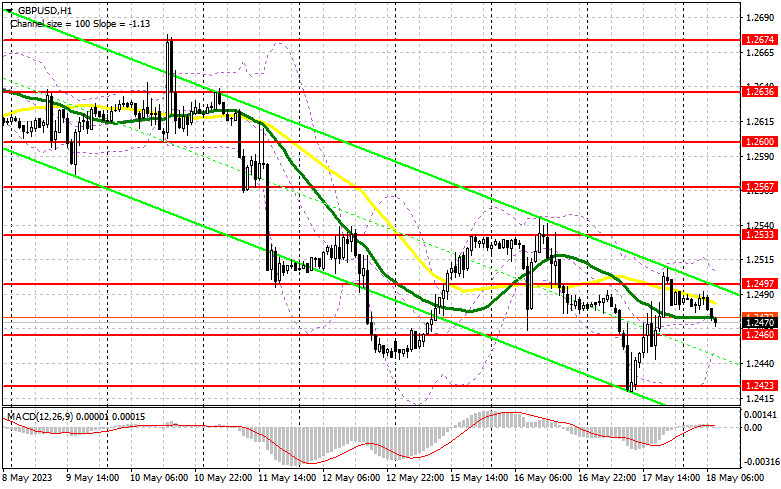
Yesterday, several entry signals were made. Let's look at the 5-minute chart to get a picture of what happened. I considered entering the market from the level of 1.2467. A breakout and a retest of this range to the upside generated an excellent sell signal, and the price dropped by more than 40 pips. The protection of the 1.2426 level created buy entry points, and quotes rose by over 25 pips. In the second half of the day, a false breakout at 1.2467 made a sell signal, which resulted in a correction of 15 pips, but growth extended.

Mixed data on the US housing market triggered a quite strong upward correction. The pound entered the sideways channel of 1.2423-1.2497, on which I will focus today. The UK Treasury Committee will conduct hearings and Bank of England Governor Andrew Bailey will speak today. In this light, we may expect a surge in GBP/USD volatility.
When to open long positions on GBP/USD:
In case of a price decline, I will open more long positions if the bulls manage to protect the nearest support level of 1.2460, formed yesterday. The price will continue recovering. A false breakout and Bailey's hawkish statements will make a buy signal in a bear market, targeting 1.2497. A breakout and consolidation above this range will generate an additional buy signal with the target at 1.2533. The most distant target is seen at 1.2567, where I will take profit.
If GBP/USD goes down and there is no bullish activity at 1.2460, the middle of the sideways channel, the bear market will continue. In that case, I will buy at 1.2423 on a false breakout. I also plan to buy GBP/USD immediately on a bounce from a low of 1.2387, allowing a correction of 30-35 points intraday.
When to open short positions on GBP/USD:
Sellers will likely update the weekly lows. The outcome of the Committee's hearings may trigger the pair's decline. However, I will not rush to open short positions today. Taking into account how active the bulls are wherever opportunity comes and how speculators behave in the absence of important statistics, I will hold off on selling until a false breakout around the nearest resistance of 1.2497 occurs. The price may then quickly go down. If no sell-off takes place, it is wiser to close short positions. In this case, the bearish target will be the middle of the sideways channel at 1.2460. A breakout and an upside retest of this range will increase pressure on GBP/USD, making a sell signal, targeting 1.2423. The most distant target remains at a low of 1.2387, where I will take profit.

If GBP/USD goes up and there is no bearish activity at 1.2497, only a false breakout through 1.2533 will produce a sell entry point. If there is no activity there too, I will sell GBP/USD from a high of 1.2567, allowing a bearish correction of 30-35 pips intraday.
The COT report (Commitments of Traders) for May 9 showed an increase in both long and short positions. Even though the Bank of England's decision to raise interest rates is not yet reflected in this data, a surge in long positions indicates the presence of GBP buyers even at current levels. Taking into account a noticeable correction at the end of last week, demand for the trading instrument will likely get stronger. According to the latest COT report, short non-commercial positions rose by 12,900 to 71,561, and long non-commercial positions surged by 9,437 to 9,437. The non-commercial net position increased to 4,528 from 1,065 a week earlier. Growth resumed after a small decrease, which will likely positively affect the pound in the future. The weekly price rose and amounted to 1.2635 against 1.2481.Indicators' signals:
Moving averages:
Trading is carried out in the area of the 30-day and 50-day moving averages, which indicates market uncertainty.
Note: The period and prices of moving averages are considered by the author on the H1 (1-hour) chart and differ from the general definition of the classic daily moving averages on the daily D1 chart.
Bollinger Bands
Support stands at 1.2460, in line with the lower band.
Description of indicators
Moving average (MA) determines the current trend by smoothing volatility and noise. Period 50. Colored yellow on the chart.Moving average (MA) determines the current trend by smoothing volatility and noise. Period 30. Colored green on the chart.Moving Average Convergence/Divergence (MACD). Fast EMA 12. Slow EMA 26. SMA 9.Bollinger Bands. Period 20Non-commercial traders are speculators such as individual traders, hedge funds, and large institutions who use the futures market for speculative purposes and meet certain requirements.Long non-commercial positions are the total long position of non-commercial traders.Non-commercial short positions are the total short position of non-commercial traders.Total non-commercial net position is the difference between the short and long positions of non-commercial traders.